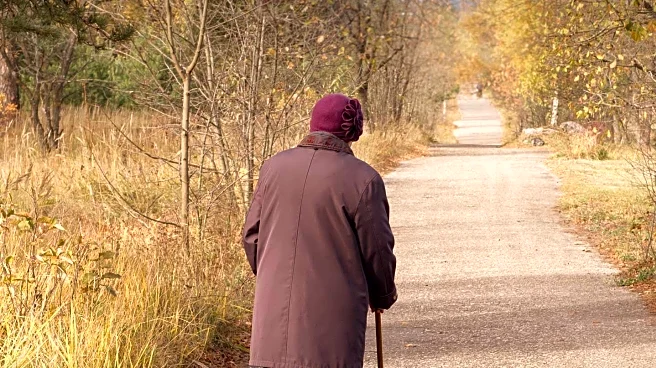What's Happening?
A recent study published in the journal Nature Medicine suggests that walking between 3,000 to 5,000 steps daily can slow the development of proteins linked to Alzheimer's disease by an average of three
years. The research, part of the Harvard Aging Brain Study, involved 296 participants aged 50 to 90, none of whom showed cognitive issues at the start. The study found that increasing daily steps to 5,000 to 7,500 further delayed protein accumulation by seven years. The benefits plateaued beyond 7,500 steps. Researchers tracked participants using pedometers over 14 years, conducting annual cognitive assessments and brain scans. The study highlights the potential of lifestyle changes in impacting the early stages of Alzheimer's disease.
Why It's Important?
This study underscores the significance of physical activity in potentially mitigating Alzheimer's disease progression, a condition affecting 6.7 million Americans, projected to rise to 14 million by 2060. Walking, particularly outdoors, offers additional health benefits such as reduced cortisol levels, improved heart rate and blood pressure, increased vitamin D, and enhanced balance and muscle tension. The findings suggest that integrating regular walking into daily routines could serve as a preventive measure against cognitive decline, offering a simple yet effective strategy for seniors to maintain brain health.
What's Next?
The study's findings may prompt healthcare providers and policymakers to advocate for increased physical activity among seniors as a preventive measure against Alzheimer's disease. Further research could explore the specific mechanisms by which walking impacts protein accumulation and cognitive health. Additionally, public health campaigns might focus on encouraging outdoor activities, leveraging the added benefits of nature exposure. As the population ages, these insights could inform strategies to reduce the burden of Alzheimer's disease on individuals and healthcare systems.
Beyond the Headlines
The study raises ethical considerations regarding access to safe walking environments, particularly for seniors in urban areas lacking green spaces. It also highlights the cultural shift towards prioritizing preventive health measures over reactive treatments. Long-term, this research could influence urban planning and community design to incorporate more accessible walking paths and parks, promoting overall public health and well-being.











